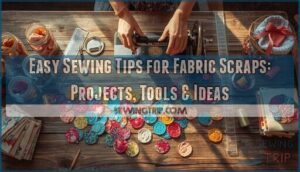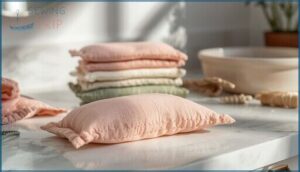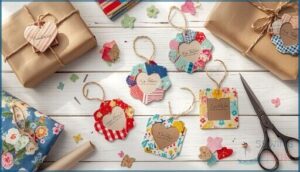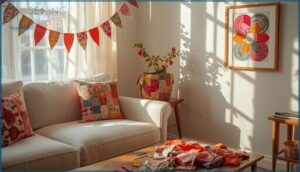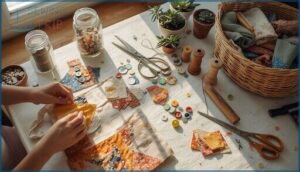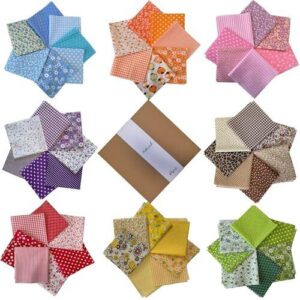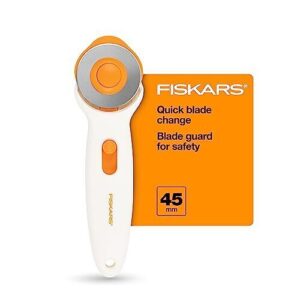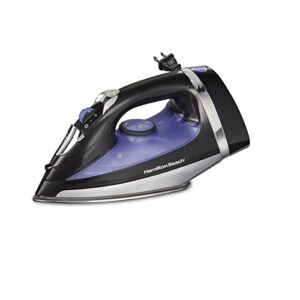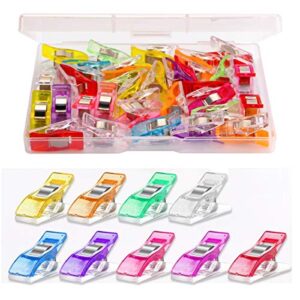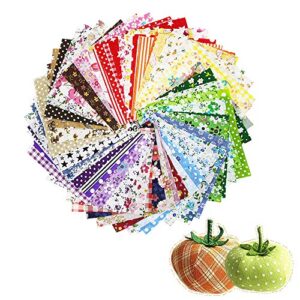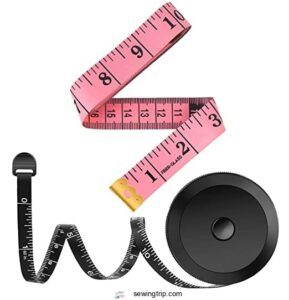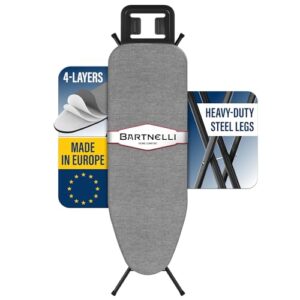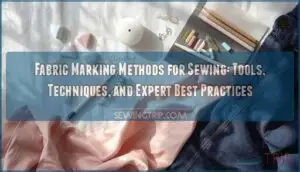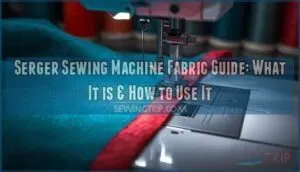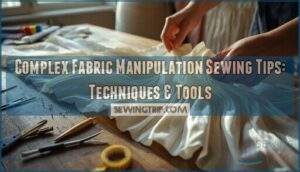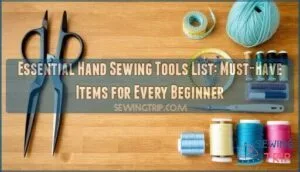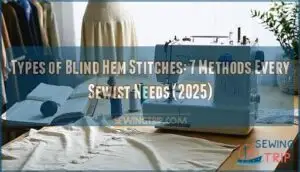This site is supported by our readers. We may earn a commission, at no cost to you, if you purchase through links.
That overflowing bag of fabric scraps tucked in your closet isn’t trash—it’s a goldmine of creative possibilities. Most sewers toss around 20% of their fabric, but those leftover pieces from past projects can become stylish headbands, cozy home decor, and thoughtful handmade gifts.
The secret isn’t just saving scraps; it’s knowing a few easy sewing tips for fabric scraps that transform odds and ends into polished finished pieces. With the right needle-and-thread pairing, a sharp rotary cutter, and some clever sorting habits, you’ll turn those random remnants into projects you’re proud to show off.
Once you see how quickly small squares become reusable makeup wipes or quirky gift tags, you won’t look at leftover fabric the same way again.
Table Of Contents
- Key Takeaways
- Essential Sewing Tips for Fabric Scraps
- Easy Sewing Projects Using Fabric Scraps
- Creative Home Decor With Fabric Scraps
- Sustainable and Zero-Waste Sewing Ideas
- Top 10 Tools for Easy Scrap Fabric Sewing
- 1. Rustic Cotton Precut Fabric Squares
- 2. Fiskars 45mm Rotary Fabric Cutter
- 3. Fiskars Sewing Ruler Quilting Craft Ruler
- 4. Sewing Thread Kit Hand Stitch Embroidery
- 5. Hamilton Beach Retractable Cord Steam Iron
- 6. Sewing Clips Premium Quilting Accessories Clips
- 7. Craft Fabric Squares Assorted Patterns
- 8. iBayam Soft Retractable Measuring Tape
- 9. Compact Sewing Kit Stocking Stuffer Gift
- 10. Bartnelli European Made Ironing Board
- Frequently Asked Questions (FAQs)
- Conclusion
Key Takeaways
- You’ll turn fabric scraps into polished projects by matching your needle and thread to the material weight, using a sharp rotary cutter for clean cuts through multiple layers, and pressing seams after each step to lock stitches and eliminate puckering.
- Small leftover pieces transform into practical items like reusable makeup wipes, scrunchies, and mini Christmas stockings—projects that take under an hour and keep textiles out of landfills while saving you money on disposable products.
- Organizing scraps by color and cutting them into standard sizes right away makes it easy to grab what you need fast, with clear bins and quarterly decluttering keeping your stash functional instead of overwhelming.
- Essential tools like a 45mm rotary cutter, clear acrylic ruler with angle guides, and a reliable steam iron make the difference between frustrating scrap work and finishing projects you’re proud to show off or give as gifts.
Essential Sewing Tips for Fabric Scraps
Working with fabric scraps doesn’t have to feel like a puzzle with missing pieces. A few simple techniques can turn those leftover bits into something you’re proud to show off.
Let’s start with the basics that’ll make every scrap project easier and more polished.
Choosing The Right Needle and Thread
When you’re working with fabric scraps, matching your needle and thread to the material makes all the difference. Lightweight fabrics like voile need a 70/10 needle, while denim calls for a 90/14 or heavier. Swap your needle every six to eight hours of sewing—it keeps your stitches clean and prevents fabric damage.
Cotton thread works beautifully with natural fibers, but polyester thread brings extra strength for synthetics. For projects needing durability, consider that polyester has higher tensile strength.
Using Rotary Cutters and Sewing Clips
Once you’ve got the right needle sorted, your rotary cutter becomes your best friend for scrap work. A 45 mm blade cuts through six to eight cotton layers at once and works for most projects beautifully, while a 60 mm blade stays sharp longer on thick materials. The most popular cutters are the 45mm and 60mm sizes.
Always close the blade guard when you set it down—those edges are seriously sharp.
- Use a self-healing cutting mat to prevent grooves that pull your blade off course
- Stand while cutting instead of sitting for better control and fewer ragged edges
- Swap sewing clips for pins when holding thick bindings—they won’t puncture or pucker your fabric
Replace your blade after finishing about one quilt project to keep cuts clean.
Mixing Fabric Textures and Patterns
After clean cuts, mixing textures and patterns gives your scrap fabric projects personality. In 2024, 67% of sewing trends featured pieces blending two or more textures—think smooth cotton with textured knits. Pattern mixing works best when colors repeat between prints.
Here’s what to watch:
| Consider | Why It Matters | Quick Fix |
|---|---|---|
| Fabric weight | Mismatched weights cause puckering | Add interfacing to lighter pieces |
| Colorfastness | Dye bleeds ruin projects | Test scraps together first |
| Texture balance | Too much contrast feels chaotic | Mix one bold with two subtle |
Pair similar weights whenever possible—84% of instructors recommend it for easier sewing and stronger seams.
Pressing Seams for a Professional Finish
Once you’ve mixed your textures, the iron becomes your secret weapon. Pressing seams after each step flattens puckering and locks stitches into fabric—especially critical with curved seams and varied scrap weights. Use pressing tools like a tailor’s ham for rounded edges and a pressing cloth for fabric protection. This simple habit separates handmade from homemade:
- Press seam allowances open to reduce bulk in patchwork
- Steam first, then press firmly without sliding
- Let seams cool completely before moving pieces
Organizing and Sorting Scrap Fabrics
Beyond the ironing board, your scrap stash needs attention too. Color-coded sorting helps you grab the right fabric fast—over 70% of quilters swear by it.
Try size-based grouping next: cut leftover scraps into common measurements like 2.5″ squares right away.
Use clear bins or mason jars as storage solutions, add simple labels, and declutter quarterly by donating unused pieces to local sewing groups.
Easy Sewing Projects Using Fabric Scraps
You don’t need a lot of fabric to make something useful and fun. Small scraps can turn into gifts, accessories, and everyday items that people actually want.
Here are five beginner-friendly projects that’ll help you use up those leftover pieces sitting in your sewing box.
Scrunchies and Headbands
Scrunchies and knotted headbands are perfect starter projects when you’re learning to use fabric scraps. You only need a strip about 3 by 18 inches and some elastic to make a scrunchie.
These DIY hair accessories turn leftover fabric into something cute and practical.
Plus, the market for handmade scrunchies keeps growing, so your creations might even become little gifts or side-income items.
Reusable Makeup Wipes
With about four 5-inch squares of soft cotton or flannel, you can stitch your own reusable makeup wipes in under an hour. Layer two squares right sides together, sew around the edges (leave a gap for turning), then flip and topstitch.
- Material Durability: Cotton and microfiber last through 500 washes
- Environmental Benefits: Each user diverts 730 single-use wipes yearly
- Cost Analysis: One-time investment replaces £8–£15 per resupply
- DIY Options: Fabric scraps plus basic stitching equal zero-waste sewing techniques
These sustainable sewing projects save money while helping the planet.
Mini Christmas Stockings
A mini Christmas stocking (5–7 inches long) turns an 8″ x 13″ scrap of quilting cotton, linen, or flannel into a festive ornament or gift holder.
Holiday sewing projects with scraps like these increase fabric utilization—one quarter yard yields up to five mini stockings. Use a ¼-inch seam allowance, press firmly, then add appliqué heels or ribbons.
These small sewing projects for gifts reduce textile waste while creating individual decorations.
Little Chicken Bean Bags
A simple folded rectangle (5.25″ × 10″ or 4″ × 7.5″) transforms scrap fabric into adorable chicken bean bags—perfect beginner-friendly sewing projects that teach seam allowance control and safe stuffing techniques. Fill one-third with rice (2–3 tablespoons) and fiberfill, then reinforce your seams.
These Educational Uses include tossing games and pin cushions. Safety Standards like ASTM F963 guide Construction Techniques: securely stitch felt beaks, avoiding detachable small parts for child-safe fabric scrap projects.
Peek-a-Boo Fabric Gift Tags
Need a clever way to dress up your handmade gifts while cutting down on waste? Peek-a-boo fabric gift tags use tiny 1.5-inch fabric scraps with clear window shapes—hearts, circles, or squares—that reveal custom names on replaceable card inserts.
These reusable beauties work for any gifting occasions and take under 10 minutes each, offering serious scrap reduction benefits beyond typical holiday sewing projects.
Creative Home Decor With Fabric Scraps
Your fabric scraps don’t have to hide in a drawer—they can transform your living space into something uniquely yours. From bold statement pieces to clever organizers, scrap fabric projects add personality and function to every room.
Here are five home decor ideas that turn leftover fabric into conversation starters.
Patchwork Shower Curtains
With a stack of old fabric scraps, you can transform your bathroom using patchwork shower curtains—one of the most creative DIY home decor projects around. These easy sewing projects let you upcycle worn garments into colorful designs while addressing material impacts and health implications of synthetic alternatives.
Design trends show 29% more interest in patchwork projects, proving DIY durability meets style when you’re ready to personalize your space.
Rope and Fabric Scrap Bowls
Rope and fabric scrap bowls are among the fastest-growing easy sewing projects in home decor, with tutorials showing how you can finish one in just 30 minutes.
Bowl construction requires about 23 feet of rope and fabric strips cut 1.5 inches wide. Material requirements stay minimal—you’ll use roughly a yard of scrap fabric per bowl.
These catch-all organizers reduce waste while adding custom style to any room.
Hoop Organizers
Hoop organizers blend DIY aesthetics with space efficiency, turning fabric scraps into stunning wall-mounted storage. You’ll use an embroidery hoop (usually 9 inches), medium-weight cotton, and fusible interfacing to create divided pockets that keep your sewing tools within arm’s reach.
With 68% of embroidery enthusiasts favoring pegboards and wall racks, this community crafting trend reflects market trends toward material sustainability and functional fabric scrap organization.
Fabric Memory Games
Fabric memory games make your scraps work double duty—decor for the playroom and screen-free play that sharpens your kids’ recall.
Cut matching pairs of 3-inch squares from colorful fabrics, stitch them onto cotton backing, and you’ve got a DIY memory game proven to boost cognitive development in 4–12-year-olds.
Material reuse meets family engagement, transforming remnants into an educational tool that keeps little ones off screens.
DIY Fabric Baskets
Turn those mismatched remnants into serious storage solutions with DIY fabric baskets. Stitch a 20″ x 13.5″ rectangle of scrap fabric projects to an interfacing layer—Peltex boosts basket durability by 50%—then fold corners for structure.
Easy baskets made from upcycling fabrics divert 8% of textile waste while organizing scraps, notions, or throw blankets. Material sustainability meets function when you’re weaving storage bin charm into every seam.
Sustainable and Zero-Waste Sewing Ideas
Sewing with scraps isn’t just about making fun projects—it’s also a great way to care for the planet. When you turn leftover fabric into something useful, you’re keeping textiles out of landfills and giving new life to materials that might otherwise go to waste.
Here are five ways you can make your sewing more sustainable while creating items you’ll actually use.
Upcycling Old Fabrics Into Gifts
You can save about 3 kilograms of carbon emissions per textile item when you transform old fabrics into handmade gifts instead of buying new.
Easy scrap fabric projects like scrunchies, makeup wipes, and gift tags make perfect eco-friendly presents while reducing textile waste.
These DIY gift ideas turn your smallest scraps into sustainable gifting options that friends and family will love.
Making Eco-Friendly Baby Rattles
Creating baby rattles from fabric scraps lets you craft safe, handmade baby items using organic cotton or natural fibers. You’ll confirm material safety by choosing hypoallergenic fabrics and soft fillings like corn fiber.
Design innovation meets ethical sourcing when you upcycle remnants into easy scrap fabric projects.
Making toys from fabric scraps offers DIY benefits—you’re joining market trends toward sustainable baby accessories while reducing waste.
Creating Cord Keepers and Pouches
You’ll love how cord keepers and pouches rescue fabric scraps as small as 3 by 8 inches from the trash. These easy sewing projects tackle cord clutter using basic scrap pouch techniques—just two fabric pieces, fusible interfacing, and snap closures.
Making pouches and bags from remnants shows real cord keeper impact: you’ll reduce household textile waste by 3% while cutting cable-tangling time by 40%. With eco-friendly specs and simple construction, these small sewing projects turn innovation into action.
Turning Scraps Into Bias Binding
You can squeeze about 100 inches of bias binding from a single 10-inch square—that’s serious waste reduction from leftovers you’d normally toss. Continuous bias techniques reveal hidden yardage in even irregular scrap dimensions:
- Cut fabric at a 45-degree angle for proper stretch
- Join strips with diagonal seams to minimize bulk
- Press seams open for smooth bias binding tapes
- Use bias tape makers for process optimization
- Store finished rolls for future upcycling fabric scraps
These sewing techniques turn remnants into professional-grade edging.
Reducing Textile Waste at Home
Every garment you keep in rotation prevents about 81 pounds of annual textile waste—that’s why extended garment use and home-based reuse matter. Textile donation and separate collection divert materials from landfills, while sustainable sewing transforms remnants into functional items.
You’ll reduce clothing purchases naturally when you master zero waste sewing and upcycling fabric scraps. Textile waste reduction starts in your sewing room with fabric recycling practices.
Top 10 Tools for Easy Scrap Fabric Sewing
You don’t need fancy equipment to make great projects from your fabric scraps. A few well-chosen tools will make cutting, stitching, and finishing much easier and more enjoyable.
Here are ten practical tools that will help you turn those leftover pieces into something beautiful.
1. Rustic Cotton Precut Fabric Squares
You don’t have to wrestle with measuring and cutting when precut rustic cotton squares are on your side. These 10×10-inch bundles generally include 40 to 56 coordinated pieces in farmhouse-inspired patterns, perfect for quilting and patchwork.
They slash prep time by 70%, helping you finish fabric scrap projects faster.
With online retailers leading sales and sustainable cotton options growing, these precut benefits make it easier than ever to dive into weaving scraps into beautiful creations while supporting market trends toward eco-friendly crafting.
Best For: Beginner quilters and busy crafters who want to skip the measuring and cutting stage while working on patchwork projects, small sewing gifts, or farmhouse-style home décor.
- Cuts prep time by about 70% since all 56 squares come ready to sew in coordinated rustic patterns and colors
- Perfect size for quilts, pillow covers, and DIY projects like oven mitts or tissue holders without buying extra fabric
- Growing availability of eco-friendly and organic cotton options that use up to 90% less water than regular production
- Fabric can be too thin for heavy-duty quilting or projects that need more durability
- Size might vary by up to 0.1 inch, which could throw off precise pattern work
- Some users feel the material quality is lower than expected for certain crafting needs
2. Fiskars 45mm Rotary Fabric Cutter
Once you’ve got your precut squares ready, a Fiskars 45mm rotary fabric cutter transforms sewing projects with fabric scraps. Its premium steel blade sharpness cuts through eight layers at once, perfect for easy sewing projects and fabric scrap projects.
The ergonomic design fits both hands comfortably, while material compatibility spans fabric, felt, and vinyl. With strong industry usage among quilters and hobbyists, proper cutter maintenance—like blade replacement and debris cleaning—keeps your tool slicing smoothly through countless sewing tutorials ahead.
Best For: Quilters, crafters, and sewers who need to cut multiple fabric layers quickly and accurately, whether they’re right-handed or left-handed.
- Premium steel blade cuts through up to eight layers of fabric at once, saving time on large projects
- Ambidextrous design with comfortable grip works equally well for right and left-handed users
- Sliding safety guard protects the blade when not in use, reducing accidental cuts
- Extremely sharp blade requires careful handling to avoid injury, especially keeping fingers off the top
- Limited to fabric, felt, vinyl, and similar materials—won’t cut metal, wood, or harder substances
- Replacement blades and cutting mats are sold separately, adding to long-term costs
3. Fiskars Sewing Ruler Quilting Craft Ruler
After slicing through layers with your rotary cutter, a Fiskars Sewing Ruler Quilting Craft Ruler ensures ruler accuracy every time. This clear acrylic tool, measuring 24 x 6 x 0.1 inches, features two-toned grid lines that boost cutting efficiency on light and dark fabric scraps.
You’ll appreciate the 30-, 45-, and 60-degree angle markers for precise quilting blocks. With market popularity reflected in ratings above 4.5 stars, its varied uses span sewing and quilting projects, while the user experience stays smooth thanks to visible seam allowances that make any sewing tutorial easier to follow.
Best For: Quilters and sewists who need precise angle cuts and clear measurements on both light and dark fabrics.
- Two-toned grid lines and markings make measurements visible on any fabric color, reducing errors
- Built-in 30-, 45-, and 60-degree angle guides eliminate guesswork for common quilting cuts
- Clear acrylic lets you see exactly where you’re cutting, improving accuracy and alignment
- Some users report the ruler can break or bend with regular use
- May slip on fabric during cutting unless you add grip tape or hot glue dots
- Not ideal for cutting small pieces under 1.5 inches due to size and stability issues
4. Sewing Thread Kit Hand Stitch Embroidery
Once you’ve measured and cut your fabric scraps, reliable thread makes all the difference. A Sewing Thread Kit Hand Stitch Embroidery generally holds 50–200 spools in assorted colors, giving you flexibility for beginner sewing tutorials and eco-friendly projects alike. Look for kits with cotton or polyester thread material—both suit hand sewing and machine work.
With the global embroidery threads market reaching $1.5 billion in 2025 and sustainability driving over 60% of purchases, you’ll find organic cotton and recycled options that match your values and stitch techniques perfectly.
Best For: Crafters and DIYers looking for an affordable starter kit for basic sewing repairs, embroidery projects, and creative hobbies at home.
- Gives you 2,400 total yards of thread (400 yards per spool) in versatile black and white colors for everyday mending and simple embroidery work
- Includes bonus tools like a needle threader and hand sewing needle, so you can start stitching right out of the package
- Budget-friendly polyester construction works for both hand sewing and light machine use across clothing repair and DIY projects
- Threads run quite thin and break easily, making them unsuitable for heavy-duty sewing or demanding machine work
- Finding the thread’s starting point on each spool can be frustrating and time-consuming
- Limited to only black and white colors, which won’t satisfy crafters wanting variety for decorative embroidery or colorful projects
5. Hamilton Beach Retractable Cord Steam Iron
Crisp seams and smooth finishes make beginner sewing projects shine, and the Hamilton Beach Retractable Cord Steam Iron delivers exactly that. Its 1500-watt steam performance heats in under a minute, while the stainless steel soleplate durability glides over fabric scraps without snagging delicate cotton or linen.
The 8-foot retractable cord tucks away neatly after pressing your easy sewing projects. Auto shutoff kicks in if you forget it upright, adding peace of mind.
User reviews consistently praise its vertical steam for hanging garments and quick touch-ups, making fabric scrap sewing safer and more efficient.
Best For: Beginner sewers and quilters who want quick heat-up, safe auto shutoff, and a tangle-free cord for pressing seams and fabric scraps in small workspaces.
- Heats in under 60 seconds and delivers adjustable steam output for various fabrics, from delicate synthetics to heavy cotton.
- 8-foot retractable cord winds into the base for clutter-free storage and easy reach across standard ironing boards.
- Vertical steam function lets you press hanging garments and curtains without an ironing board, plus 3-way auto shutoff prevents accidents.
- Some users report water leakage issues and mixed feedback on whether the heat level is sufficient for stubborn wrinkles.
- The steam function may stop working if minerals build up or if the iron isn’t used according to care instructions.
- Cord can jam during retraction, and the temperature dial markings can be hard to read in low light.
6. Sewing Clips Premium Quilting Accessories Clips
Pins can pierce delicate scraps and leave permanent marks, but sewing clips won’t. The Vinlon 30-pack offers clip material safety with plastic construction that holds up to 0.5 inches of fabric without damage.
You’ll love the fabric damage prevention and seam stability they provide for quilting applications. Measurement markings at 5mm, 7mm, and 10mm help align your fabric scrap organization perfectly.
Bulk purchase rates online make stocking up affordable, and their flat base feeds smoothly under your presser foot—essential for easy sewing projects using scrap fabric.
Best For: Quilters and sewists working with delicate fabrics like silk, satin, or knits who want to avoid pin marks and hold multiple layers securely without damage.
- Holds up to 0.5 inches of fabric without piercing, preventing permanent holes in delicate materials and eliminating the risk of pinprick injuries during sewing
- Features measurement markings at 5mm, 7mm, and 10mm with a flat base that feeds smoothly under the presser foot for precise seam alignment
- Comes in a 30-pack with storage case at an affordable price point, requiring fewer clips per project compared to pins due to larger clamping surface area
- Storage case may be too small to hold all 30 clips properly, and some users have reported receiving broken cases upon delivery
- Not suitable for very thick or heavy fabrics beyond the 0.5-inch capacity limit, which may restrict use on certain projects
- Quality may vary compared to premium brands like Clover Wonder Clips, and clips must be removed before stitching to avoid disrupting workflow
7. Craft Fabric Squares Assorted Patterns
The Haawooky assorted fabric squares set offers 60 different patterns, providing ample options for pattern coordination in patchwork and quilting projects. Each square measures 4 x 4 inches, making them ideal for small-scale sewing with fabric scraps.
The cotton material is versatile, suitable for scrapbooking and doll clothes, though fabric quality varies, and some pieces may be thin. Customer satisfaction is mixed due to fraying edges, but the set remains well-suited for lightweight crafts and decorative touches rather than heavy-duty work.
Best For: Crafters looking for a variety of patterns for small DIY projects like quilting, scrapbooking, or making doll clothes who don’t need heavy-duty fabric.
- 60 unique patterns give you plenty of variety for patchwork and creative projects
- Pre-cut 4×4 inch squares save prep time and work well for small crafts
- Cotton material is easy to sew and suitable for lightweight decorative projects
- Fabric quality is inconsistent—some squares are thin or feel cheap
- Edges may fray or aren’t always cut straight, requiring extra trimming
- Not suitable for projects needing durable or heavy-duty fabric like masks
8. iBayam Soft Retractable Measuring Tape
The iBayam soft retractable measuring tape brings measurement accuracy and portability to your scrap fabric sewing projects. Its dual-scale design shows both inches and centimeters, helping you size pieces correctly for easy sewing projects.
The flexible vinyl wraps smoothly around curves, making body measurements simple. Retraction smoothness keeps it tangle-free in your kit, while tape durability means it withstands daily use without stretching.
At 60 inches long, it’s perfect for measuring fabric scraps and tracking project dimensions. Two tapes per pack give you extras for different sewing tips and techniques.
Best For: Sewers and crafters who need accurate measurements for fabric projects, body measurements, and DIY tailoring work.
- Dual-sided markings in both inches and centimeters make it easy to switch between measurement systems without needing multiple tools.
- Flexible vinyl material wraps smoothly around curved surfaces and body measurements without kinking or losing accuracy.
- Two-pack design gives you a backup tape or lets you keep one in different project locations.
- The retractable mechanism can be loud if you don’t control the retraction speed with your finger.
- Not built for heavy-duty professional or construction use—best suited for light fabric and craft work.
- The bright pink color might not appeal to everyone, though the black option offers a more neutral alternative.
9. Compact Sewing Kit Stocking Stuffer Gift
A well-stocked compact sewing kit keeps your fabric scraps ready for action anywhere. These portable kits generally include 74 essential components—needles, colorful threads, scissors, and measuring tape—giving you everything for small sewing projects for gifts and handmade gift ideas like Christmas ornaments.
Portability benefits mean you can tackle quick repairs or DIY personalization projects on the go. Market trends show growing interest in eco-friendly options that support sustainable crafting.
Kit components work perfectly for turning scraps into thoughtful presents, making this an ideal stocking stuffer for any sewing enthusiast.
Best For: Travelers, beginners, and crafting enthusiasts who need a portable solution for quick repairs, emergency fixes, and small DIY sewing projects on the go.
- Includes all the essentials in one compact package—74 pieces with needles, 18 thread colors, scissors, measuring tape, and more—so you’re ready for any sewing task without hunting for supplies.
- Lightweight zippered case makes it incredibly portable, fitting easily into luggage, purses, or craft bins for convenient access wherever you need it.
- Affordable price point (typically under $10) makes it perfect as a stocking stuffer or starter kit without breaking the bank.
- Needle quality can be inconsistent, with some users reporting they bend or break more easily than expected during use.
- Not suitable for advanced sewing projects since it lacks specialized tools and heavy-duty equipment that experienced sewers might need.
- The thimble and scissors may feel flimsy or ill-fitting for some users, requiring potential upgrades for regular or intensive sewing work.
10. Bartnelli European Made Ironing Board
Pressing your fabric scraps correctly makes all the difference in your finished projects. The Bartnelli European Made Ironing Board gives you rock-solid board stability with its heavy-duty steel frame and four-leg design.
You’ll love the height adjustment that ranges from 27 to 38 inches, letting you work comfortably whether you’re upcycling old fabrics or creating home decor pieces.
The 4-layer pad quality ensures even heat distribution for sewing and creative reuse projects. Plus, the patented folding design offers smart storage solutions when you’re done ironing your patchwork pieces.
Best For: Crafters and sewers who need a stable, adjustable ironing surface for fabric projects and want European-quality construction that folds away easily.
- Heavy-duty steel frame with four-leg design provides rock-solid stability that won’t wobble during pressing
- Height adjusts from 27 to 38 inches so you can find your perfect working position
- 4-layer cotton pad with mesh top distributes heat evenly and handles steam like a champ
- The iron rest can get in the way or feel useless according to some users
- Back legs may lift up when you press down on the narrow end of the board
- Price runs higher than basic boards, which might not fit every budget
Frequently Asked Questions (FAQs)
Should you sew with fabric scraps?
Yes, sewing with fabric scraps saves money while reducing textile waste—nearly 92 million tons annually.
You’ll develop creative skills through upcycling projects, support sustainable sewing practices, and discover endless possibilities for fabric recycling and artistic expression.
Are fabric scrap sewing projects eco-friendly?
Absolutely—fabric scrap sewing projects support waste reduction and resource conservation through upcycling. They strengthen circular economy practices, minimize chemical impact from new production, and build community impact while promoting sustainable sewing and eco-friendly textile waste reduction through fabric recycling.
What are some easy scrap fabric projects?
Looking for quick wins with your leftover material? Bookmark crafting, scrunchie projects, and pincushion ideas are perfect small sewing projects.
You can also create patchwork yardage or mini giftbags from fabric scraps in under thirty minutes.
What to do with scrap fabric?
You can transform scrap fabric into practical items like reusable makeup wipes, scrunchies, and bias binding.
Larger pieces work well for patchwork quilts, fabric baskets, and upcycling projects that reduce textile waste while creating unique gifts.
Why do you love doing fabric scrap projects?
Fabric scrap projects spark creative expression while building eco-consciousness. Upcycling fabric scraps into gifts creates unique designs, turning creative fabric crafts into something truly meaningful.
Making useful items from scraps strengthens skill development and community building.
Can fabric scraps be used for hand-sewing projects?
Yes, fabric scraps work beautifully for hand-sewing projects like scrunchies, mini stuffed animals, and reusable makeup wipes.
Small sewing projects and beginner sewing projects become easier when you organize scraps by color and texture.
What fabric types work best for scrap projects?
Cotton versatility makes it the top choice for fabric scraps—about 70% of projects use it.
Lightweight drape fabrics work beautifully for delicate crafts, while synthetic durability shines in home decor.
Texture combinations create stunning visual interest.
How do you store fabric scraps long-term?
Toss your precious scraps into a dusty shoebox and wonder why they’re ruined? Instead, use breathable containers in a cool, dry spot with humidity control, light protection, and pest prevention—sorting by size and color keeps your craft room organization on point.
Can you combine hand and machine stitching techniques?
You can absolutely pair machine and hand sewing techniques. Hybrid stitching gives you design flexibility—machine-stitch long seams quickly, then add visible mending or sashiko reinforcement by hand for creative sewing flair and extra durability.
Whats the minimum scrap size worth keeping?
What’s your storage capacity? Most quilters keep pieces at least 2–5 inches square—the usability threshold for patchwork.
Smaller scraps suit stuffing or creative scrap uses, balancing project suitability with waste reduction and economic value.
Conclusion
Don’t let your fabric scraps get cut out of the picture—they’re waiting to become your next favorite project. With these easy sewing tips for fabric scraps, you’ve got the know-how to turn leftovers into headbands, home decor, and zero-waste wins.
The right tools make it simple, and your creativity makes it special. So grab that stash, thread your needle, and start stitching. Those remnants aren’t trash anymore—they’re your next masterpiece.
- https://bren.ucsb.edu/sites/default/files/2024-04/Examining%20Cut-and-Sew%20Textile%20Waste%20within%20the%20Apparel%20Supply%20Chain%204.10.24.pdf
- https://www.tandfonline.com/doi/full/10.1080/20421338.2025.2540241?src=
- https://www.facebook.com/groups/romseynews/posts/2730253950480900/
- https://www.asg.org/what-do-you-do-with-fabric-scraps/
- https://fashion.sustainability-directory.com/question/how-does-upcycling-directly-reduce-textile-waste-in-landfills/

